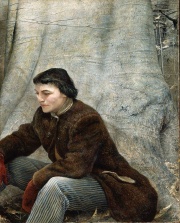Egg tempera
Description
A tempera paint prepared with the whole Egg, the yolk, or the white as a medium. Egg yolk is a natural emulsion containing a homogeneous mixture of lipids and water. Lecithin and Albumen act as emulsifying agents. Traditionally, the pure egg yolk, with its surface delicately dried by rolling in the palms, was poured from its yolk sac then ground with pigments. Vinegar or Clove oil was sometimes added as a preservative. Other recipes use whole egg, as an emulsifier, mixed with Linseed oil and water (see Tempera grassa). Occasionally a natural resin was also added. Some sulfur containing pigments, Vermilion, and cadmium colors, are incompatible with egg tempera (Doerner, 1934).
Synonyms and Related Terms
tempera de huevo (Esp.); tempera magra (Esp.); tempera à l'œuf (Fr.); têmpera de ovo (Port.)
Physical and Chemical Properties
- Refractive Index = 1.346
Resources and Citations
- Art and Architecture Thesaurus Online, http://www.getty.edu/research/tools/vocabulary/aat/, J. Paul Getty Trust, Los Angeles, 2000
- R. J. Gettens, G.L. Stout, Painting Materials, A Short Encyclopaedia, Dover Publications, New York, 1966
- M. Doerner, The Materials of the Artist, Harcourt, Brace & Co., 1934
- Reed Kay, The Painter's Guide To Studio Methods and Materials, Prentice-Hall, Inc., Englewood Cliffs, NJ, 1983
- Ralph Mayer, A Dictionary of Art Terms and Techniques, Harper and Row Publishers, New York, 1969 (also 1945 printing)
- Thomas B. Brill, Light Its Interaction with Art and Antiquities, Plenum Press, New York City, 1980
- Teri Hensick, contributed information, 1998
